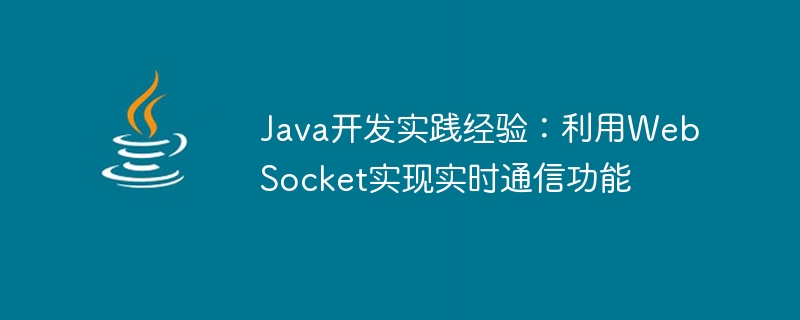
Java development practical experience: using WebSocket to realize real-time communication function
With the rapid development of the Internet, real-time communication has become indispensable in modern application development part. Whether it is an online chat application, a stock quote display or an online gaming system, real-time communication plays a crucial role. At present, WebSocket has been widely used as a technology for realizing real-time communication, and in Java development, using WebSocket to realize real-time communication functions has also become a hot topic. This article will introduce the practical experience of using WebSocket to achieve real-time communication in Java development, and share some technical points and precautions.
1. What is WebSocket
WebSocket is a protocol for full-duplex communication on a single TCP connection. Unlike the HTTP protocol, the WebSocket protocol can establish a persistent connection between the client and the server to achieve real-time two-way data transmission. This feature allows WebSocket to be well used in real-time communication fields, such as online chat, real-time data display, etc.
2. How to implement WebSocket
In Java development, implementing the WebSocket function mainly relies on the JSR-356 specification provided by the Java EE platform. The JSR-356 specification provides a set of APIs for implementing WebSocket functions, including annotations, interfaces, classes, etc. Using the JSR-356 specification, developers can easily implement WebSocket server-side and client-side functions.
The implementation of WebSocket server usually needs to inherit the Endpoint class and implement onOpen, onClose, onMessage and other methods. The WebSocket client can identify the WebSocket connection point through the javax.websocket.ClientEndpoint annotation and implement the corresponding method in the connection point to process the message.
3. Practical experience
- Choose the appropriate development framework
In the actual development process, choosing the appropriate development framework is crucial to realizing the WebSocket function. For Java developers, the Java EE platform provides many excellent development frameworks, such as Spring, Jersey, etc. These frameworks provide rich functions and easy-to-use APIs, and can well support the development and integration of WebSocket.
- Reasonable design of message transmission format
When implementing real-time communication functions, it is very important to design a reasonable message transmission format. Under normal circumstances, JSON format is a commonly used message transmission format, and the use of JSON format can well support the transmission of complex data structures, and it is also convenient for clients to parse and process.
- Handling connection exceptions and errors
During the real-time communication process, connection exceptions and errors may occur due to network fluctuations, server instability, etc. Therefore, timely handling of connection exceptions and errors is the key to ensuring the stability of real-time communication. Developers need to design reasonable exception handling strategies based on specific business scenarios to ensure that users can be notified in time or perform automatic reconnection when an exception occurs.
- Reasonably control the frequency of message sending
In real-time communication, sending messages frequently will increase the burden on the server and network and put certain pressure on system performance. Therefore, developers need to reasonably control the frequency of sending messages to avoid system performance degradation due to too many messages. You can reduce the frequency of message sending and improve system performance through message merging and message compression.
- Security considerations
In the implementation of real-time communication functions, security is a very important consideration. Developers need to consider how to ensure the secure transmission of data, and do a good job in user identity authentication, data encryption, etc. SSL/TLS encryption protocol, OAuth authentication, etc. can be used to enhance communication security.
4. Precautions
- Performance considerations in high concurrency scenarios
In real-time communication systems, you usually face a large number of concurrent connections and message processing. Therefore, when designing and implementing WebSocket functions, you need to fully consider the performance in high concurrency scenarios. Performance issues. Properly designing the system architecture, optimizing message processing logic, and properly tuning server configurations are all key factors in improving system performance.
- Cross-domain access support
In actual applications, the client and server may be located under different domain names, which involves the issue of cross-domain access. Developers need to make corresponding cross-domain access settings on the server side to ensure that the client can connect and communicate normally.
- Fault-tolerant processing of unstable network environment
Due to the instability of the network environment, problems such as disconnection and message loss may occur. Developers need to perform corresponding fault-tolerance processing on the client and server sides to ensure that connections can be restored in time and communication can continue when network abnormalities occur.
Through the introduction of this article, readers can learn about some practical experience and technical points of using WebSocket to achieve real-time communication in Java development. As an important part of modern application development, real-time communication has become an indispensable part. By properly selecting the development framework, designing message transmission formats, and handling connection exceptions and errors, developers can well implement high-performance, stable, and secure real-time communication functions to meet users' needs for real-time communication. I hope this article can provide readers with some reference and help in actual development and further improve the development level of real-time communication functions.
(Word count: 1032)
The above is the detailed content of Practical experience in Java development: using WebSocket to achieve real-time communication functions. For more information, please follow other related articles on the PHP Chinese website!


